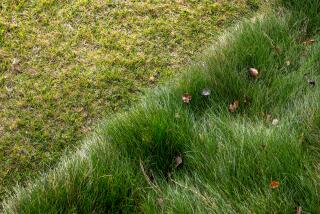GARDENING : When It Comes to Grass, Remember, Some Like It Cool
- Share via
Just because vegetables and flowers are waning with cool weather and trees are losing their leaves does not mean that the grass has stopped growing.
Cool-season grasses--such as fescues and bluegrasses--are so-called because they make most of their growth during the cool, moist months of spring and fall.
Continue to mow, as needed, but do not mow too closely. Those blades of grass are what make food for grass plants, and the plants should not enter the winter hungry. Mow no lower than 1 1/2 to 2 inches.
If the mower spews out thick clumps of chopped grass and leaves in its wake, then you will have to rake or attach the mower’s grass catcher. Otherwise, those thick clumps are apt to mat down and smother the lawn, inviting fungal diseases.
If you have been mowing regularly, and large-leaved trees such as sycamores or maples do not tower over your lawn, your mower probably can grind up and throw around leaves and grass well enough so that you do not have to rake.
Allowing leaves and cut grass to remain in place actually improves the lawn. Earthworms will pull these materials down into the soil and chew them up, turning them into rich humus which, in turn, will feed your lawn next year and keep the soil spongy and soft.
While you are cutting, think back to last summer. Was the lawn a lush, green carpet, or was it somewhat sickly? Perhaps it was underfed.
Nitrogen is the nutrient most needed in a lawn fertilizer, so look for bags of fertilizer with an N-P-K ratio of about 2-1-1 (such as 20-10-10, 10-5-5, etc.).
Fertilizers least likely to leach out of the soil by spring are organic fertilizers, slow-release fertilizers, and those whose nitrogen is in the ammonium form. All this is spelled out in fine print on the fertilizer bag.
A soil test will tell you how much fertilizer to use. But once you get going sprucing up the lawn, you probably do not want to stop, take a test, then wait a couple of weeks for the results. So here’s a rule of thumb:
Each year add about 10 pounds of a fertilizer with 10% nitrogen (i.e., one pound of actual nitrogen) for every thousand square feet of lawn. Less fertilizer is needed for already-fertile soils, for grasses made up mostly of fescues and for those who want to spend less time mowing.
A soil test also tells you if your lawn needs to be “sweetened” with lime, which is needed periodically for many soils. Barring the soil test, here’s another rule of thumb: Add 50 pounds of ground limestone per thousand square feet every two or three years.
Lime normally washes into the soil slowly, but small fissures left by alternate freezing and thawing will help work the lime into the soil during the coming months.
Don’t try to spread fertilizer or lime by taking a handful at a time and scattering it by swinging your arm in graceful arcs. Similar graceful patterns will appear on the lawn next year, wherever the fertilizer was concentrated.
Get a push-spreader that rolls on the ground, or a hand-cranked broadcaster that hangs on your chest with shoulder straps and spews out its contents as you crank. Two passes at right angles to each other, with half the fertilizer or lime applied at each pass, ensures an even distribution of material.
The final lawn task is to sharpen your mower’s blades before putting the mower away for winter.





